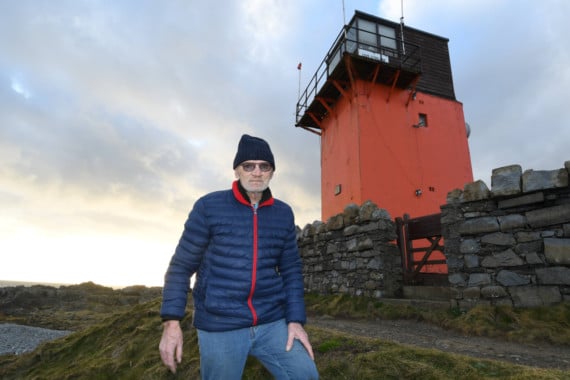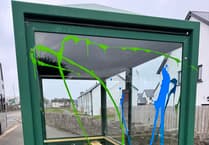In an abandoned coastguard’s tower, out of view of the public and with views of Langness and the Calf of Man, Ronnie Allcote lives out his favourite pastime, amateur radio. Reporter Jess Ward met him at Scarlett Tower to find out more.
They call me ’Captain Scarlett’ here in Castletown, said Ronnie.
The 71-year-old shows me a mug with the Scarlett Tower printed on it while we stand in a small kitchen at the base of the tower - one that he says he’s rented for ’years and years’.
’I wanted it for the history,’ he said. ’It was built in 1950s and in 1971 the coastguard left. I rent it from the landowner for £1 a month.
’There was no glass in the windows when I came, no roof, no electric or running water. Someone fitted the electric for me for free. I was very excited turning on the lights after that.
’I come here as much as I can and sometimes it’s for just a cup of tea and a sulk.’
Ronnie, a former builder, guides himself expertly and quickly up the ladders mounted onto the tower’s walls and up through the trap in the ceiling.
I follow at a more cautious pace and soon we reach the top floor where a view of the open sea greets us.
To your left is Langness and its shiny, white lighthouse beaming at you and on your right, in the distance are Chicken Rock and the Calf of Man. The views are just incredible and you instantly feel the urge to sit down and take it all in.
After doing so, I look around at the inside of this landmark tower which stands proudly on the edge of the sea in Scarlett, Castletown.
It’s dated and a bit damp, but it is loved with model ships and boats filling windowsills, flags from various places, webcams looking out and chairs for prospective guests.
Straightaway Ronnie goes to the chair in the right corner where his Ham radio sits, catching his attention.
’I got my Ham licence about 40 years ago. It was a lovely feeling. It’s like passing your test - I will always remember that day,’ he said.
Ham radio is amateur radio. It is used for non-commercial purposes such as exchanging messages, wireless experimentation, private recreation, emergency communication and more using the radio frequency spectrum. It has passed its heyday with the rise of the internet making it easy for all to communicate.
Using his equipment, Ronnie has spoken to a number of people from all over the world and loves telling them about the Isle of Man.
’Ham radios use no computers, no florescent lights and there is nothing to interfere with your conversation with someone,’ he said.
’I’m not paying for it and I like talking to people. I’ve talked to people from all walks of life, including a surgeon in America. ’I know it sounds old-fashioned, but it’s a lovely thing,’ he said.
His earliest memory of being interested in radio is when he first got a toy Dandeer set at the age of eight, which had Morse code imprinted on it. ’I learnt from that,’ he said.
Ronnie feels great joy when sharing his passion and about the place where he was born.
He has live webcams streaming views of the Isle of Man and often has friends from abroad drop into the tower to have a chat and use their Ham devices.
People have come from as far afield as Australia and the United States to see Ronnie and the tower, which was once the base for coastguards ensuring ships that left from Merseyside reached this lookout point safely on the way to their destination in Ireland or Northern Ireland.
Ronnie said: ’I should be paid by the tourist board for bringing people here!’
He adds that he would like to have an open day, possibly this TT, where Manx residents and visitors could pop by and have a look at the tower for themselves.
Climbing back down (very carefully) and coming out into the blustery wind, Ronnie fixes an aerial before making his way back down the track.
He points to things along the way and talks about them with great interest, cracking jokes along the way.

.jpeg?width=209&height=140&crop=209:145,smart&quality=75)



Comments
This article has no comments yet. Be the first to leave a comment.